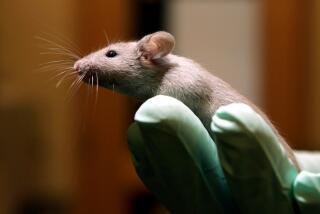Adult human skin cells converted directly to blood cells, skipping intermediate stem cell step
- Share via
Canadian scientists have turned human skin cells directly into blood cells, the first time one kind of mature human cell has been converted into another, they reported Sunday in the journal Nature.
The transformation was completed without first rewinding the skin cells into the flexible pluripotent stem cells that have most frequently been used to grow needed tissues. By skipping the pluripotent step, the researchers believe they have skirted the risk that the replacement cells might form dangerous tumors.
The team created blood progenitor cells — the mother cells that multiply to produce other blood cells — as well as mature blood cells, according to the report. Both types of cells could be useful in medical treatments, said study leader Mick Bhatia, a stem cell scientist at McMaster University in Hamilton, Ontario.
“There is a great need for alternative sources of human blood,” Bhatia said. “Since this source would come from a patient’s own skin, there would be no concern of rejection of the transplanted cells.”
Bhatia’s team has been focused on generating blood cells for more than 10 years. For much of that time, the team has concentrated on adult stem cells, which, through careful manipulation, can be programmed to become other types of cells.
But for multiple reasons, the stem cells weren’t very efficient at generating blood cells that were suitable for clinical use, he said. So for the past two years, the team also tried converting skin cells directly into blood cells.
The scientists used a trial-and-error approach to figure out which genes needed to be activated to reprogram the cells into blood cells. Then they looked for the right combination of growth factors — blood proteins that promote development of the new cells — they’d need to coax the process along.
They found that they needed to turn on a single gene — called OCT4 — in the skin cells, and that the cells needed to bathe in precisely calibrated combinations of four to six growth factors to make a variety of blood cell types, Bhatia said. The approach worked with skin cells taken from adults and from the discarded foreskins of newborns.
By tweaking the formula, the team was able to produce different types of blood cells, Bhatia said. For example, when they left out the protein called erythropoietin, the skin cells generated neutrophils and macrophages — types of white blood cell used by the immune system — but no red blood cells.
To determine whether the cells had the potential to grow once placed in the body, the team injected some its blood cells into mice. Some human blood cells did grow in the animals, the researchers found.
They also tested the cells in mice to see if they would generate cancer. They did not.
Direct conversion of skin cells into blood cells might skirt some complications posed by generating blood with stem cells. Though they are prized for their flexibility, they also have a tendency to grow in uncontrolled ways that form tumors.
However, it’s not yet clear whether the blood cells generated directly from skin will pose safety concerns of their own. Bhatia said he is seeking research partners to study the risks associated with the new technique and to determine whether it works at the “industrial levels” suitable for generating the large numbers of blood cells a patient might need.
Assuming “everything goes well,” he said, he hopes to begin clinical trials by 2012.







